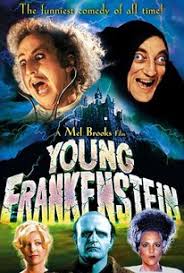
Dr. Frederick Frankenstein (Gene Wilder) is the grandson of the famous Victor Frankenstein. He is a professor at an American medical school. He insists on being called Fronkensteen to try to distance himself from his family legacy. After one of his lectures he is approached by the Frankenstein family attorney. He carries with him Frederick’s great grandfather’s will. It appears that Frederick has inherited the family estate in Transylvania. Leaving his fiancé Elizabeth (Madeline Kahn) in America he travels to Transylvania to inspect the property.
At the Transylvania station he is met by Igor, a hunchback whose grandfather use to work for Frederick’s grandfather and Inga (Teri Garr), who was hired to be his assistant. At the castle they are met by the housekeeper Frau Blucher (Cloris Leachman). Blucher settles Frederick in the Baron’s old room. During the night Frederick has a nightmare and is woken up by Inga.
They hear music that seems to be coming from behind the bookcase. They inspect it and find behind it a passageway. They follow it to a stone stairway. At the bottom is a door. Inside they find a room and Igor. The three of them continue on until they find the hidden laboratory of Baron Victor Frankenstein. Then they find his library and his papers. Among them are instructions on how to create a reanimated human. Frederick pores over the papers. Something within him changes and he now believes his destiny is to follow in his grandfather’s footsteps.
Frederick and Igor dig up the body of a recently executed criminal. With the body safely in his laboratory Frederick now needs a brain. He sends Igor to the Brain Depository to steal the brain of H. Delbruck. Frightened by seeing his own reflection in a mirror Igor drops the brain. He grabs one labeled abnormal and brings it to Frederick. After Frederick puts the brain in the monster he eventually manages to animate it. The monster (Peter Boyle) begins to walk around until Igor lights a match. Then the monster goes on a rampage until it is given a sedative. Frederick then finds out about the switch in brains.
While Frederick is trying to figure out what to do with the monster the towns people are upset that there is a Frankenstein once again in their midst. Inspector Kemp (Kenneth Mars) visits the doctor to make sure nothing hinky is going on at the castle. Then Frau Blucher decides to let the creature go.
“Young Frankenstein” was released in 1974 and was directed by Mel Brooks. It is a comedy based on the characters from Mary Shelly’s 1818 horror story “Frankenstein; or The Modern Prometheus”. The film takes elements from the Frankenstein franchise movies “Frankenstein” 1931, “The Bride of Frankenstein” 1935, “Son of Frankenstein” 1939, and “The Ghost of Frankenstein” 1942. It was filmed in black and white.
One of my favorite Mel Brooks movies, the film shows what a parody is suppose to look like while adding in some great improvisational gags by an array of great actors. Mel Brooks’ insanity is contagious and we get to reap the benefits of it.
The electrical whiz bang machinery in the original Universal Frankenstein film was created by Ken Strickfaden. Upon finding that Strickfaden was still alive Mel Brooks went to see him and found that he still had all his elaborate gizmos stored in his garage. Brooks rented the equipment and gave Strickfaden a screen credit, something he never got for the original films.
At first Brooks thought that the Marty Feldman "Walk this way" gag in the film was too corny. He was going to cut it from the film until he saw the audience's reaction to it at a screening. It gained so much popularity that he included variations of it in “History of the World: Part I” 1981 and “Robin Hood: Men in Tights” 1993. The skit was also the inspiration for Steven Tyler to write the Aerosmith hit “Walk This Way”.
During the scene where the monster is being brought back to life, the area around his eyes and brain begins to glow. The effect was done with a light inside a plastic head of Peter Boyle.
Marty Feldman ad-libbed the shifting hump on Igor's back. He had been shifting the hump back and forth for several days before cast members finally noticed. Brooks then added it to the script. Mel Brooks wanted costume designer Dorothy Jeakins to have Madeline Kahn show as much cleavage as possible in her outfits. Due to the Motion Picture Production code the original pre-code “Frankenstein” movie got away with showing more than the 1974 movie could.

